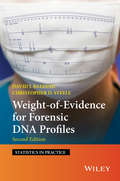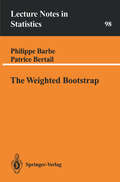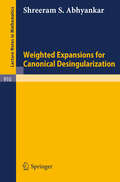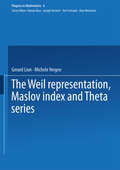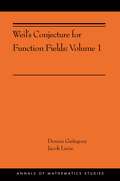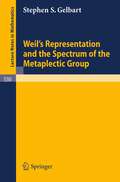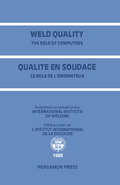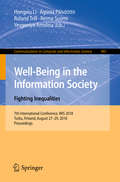- Table View
- List View
Weight-of-Evidence for Forensic DNA Profiles (Statistics in Practice #34)
by David J. Balding Christopher D. SteeleDNA evidence is widely used in the modern justice system. Statistical methodology plays a key role in ensuring that this evidence is collected, interpreted, analysed and presented correctly. This book is a guide to assessing DNA evidence and presenting that evidence in a courtroom setting. It offers practical guidance to forensic scientists with little dependence on mathematical ability, and provides the scientist with the understanding they require to apply the methods in their work. Since the publication of the first edition of this book in 2005 there have been many incremental changes, and one dramatic change which is the emergence of low template DNA (LTDNA) profiles. This second edition is edited and expanded to cover the basics of LTDNA technology. The author's own open-source R code likeLTD is described and used for worked examples in the book. Commercial and free software are also covered.
Weight-of-Evidence for Forensic DNA Profiles (Statistics in Practice)
by David J. Balding Christopher D. SteeleDNA evidence is widely used in the modern justice system. Statistical methodology plays a key role in ensuring that this evidence is collected, interpreted, analysed and presented correctly. This book is a guide to assessing DNA evidence and presenting that evidence in a courtroom setting. It offers practical guidance to forensic scientists with little dependence on mathematical ability, and provides the scientist with the understanding they require to apply the methods in their work. Since the publication of the first edition of this book in 2005 there have been many incremental changes, and one dramatic change which is the emergence of low template DNA (LTDNA) profiles. This second edition is edited and expanded to cover the basics of LTDNA technology. The author's own open-source R code likeLTD is described and used for worked examples in the book. Commercial and free software are also covered.
Weighted and Fuzzy Graph Theory (Studies in Fuzziness and Soft Computing #429)
by Sunil Mathew John N. Mordeson M. BinuOne of the most preeminent ways of applying mathematics in real-world scenario modeling involves graph theory. A graph can be undirected or directed depending on whether the pairwise relationships among objects are symmetric or not. Nevertheless, in many real-world situations, representing a set of complex relational objects as directed or undirected is not su¢ cient. Weighted graphs o§er a framework that helps to over come certain conceptual limitations. We show using the concept of an isomorphism that weighted graphs have a natural connection to fuzzy graphs. As we show in the book, this allows results to be carried back and forth between weighted graphs and fuzzy graphs. This idea is in keeping with the important paper by Klement and Mesiar that shows that many families of fuzzy sets are lattice isomorphic to each other. We also outline the important work of Head and Weinberger that show how results from ordinary mathematics can be carried over to fuzzy mathematics. We focus on the concepts connectivity, degree sequences and saturation, and intervals and gates in weighted graphs.
Weighted Approximation with Varying Weight (Lecture Notes in Mathematics #1569)
by Vilmos TotikA new construction is given for approximating a logarithmic potential by a discrete one. This yields a new approach to approximation with weighted polynomials of the form w"n"(" "= uppercase)P"n"(" "= uppercase). The new technique settles several open problems, and it leads to a simple proof for the strong asymptotics on some L p(uppercase) extremal problems on the real line with exponential weights, which, for the case p=2, are equivalent to power- type asymptotics for the leading coefficients of the corresponding orthogonal polynomials. The method is also modified toyield (in a sense) uniformly good approximation on the whole support. This allows one to deduce strong asymptotics in some L p(uppercase) extremal problems with varying weights. Applications are given, relating to fast decreasing polynomials, asymptotic behavior of orthogonal polynomials and multipoint Pade approximation. The approach is potential-theoretic, but the text is self-contained.
Weighted Automata, Formal Power Series and Weighted Logic (BestMasters)
by Laura WirthThe main objective of this work is to represent the behaviors of weighted automata by expressively equivalent formalisms: rational operations on formal power series, linear representations by means of matrices, and weighted monadic second-order logic. First, we exhibit the classical results of Kleene, Büchi, Elgot and Trakhtenbrot, which concentrate on the expressive power of finite automata. We further derive a generalization of the Büchi–Elgot–Trakhtenbrot Theorem addressing formulas, whereas the original statement concerns only sentences. Then we use the language-theoretic methods as starting point for our investigations regarding power series. We establish Schützenberger’s extension of Kleene’s Theorem, referred to as Kleene–Schützenberger Theorem. Moreover, we introduce a weighted version of monadic second-order logic, which is due to Droste and Gastin. By means of this weighted logic, we derive an extension of the Büchi–Elgot–Trakhtenbrot Theorem. Thus, we point out relations among the different specification approaches for formal power series. Further, we relate the notions and results concerning power series to their counterparts in Language Theory. Overall, our investigations shed light on the interplay between languages, formal power series, automata and monadic second-order logic.
The Weighted Bootstrap (Lecture Notes in Statistics #98)
by Philippe Barbe Patrice BertailINTRODUCTION 1) Introduction In 1979, Efron introduced the bootstrap method as a kind of universal tool to obtain approximation of the distribution of statistics. The now well known underlying idea is the following : consider a sample X of Xl ' n independent and identically distributed H.i.d.) random variables (r. v,'s) with unknown probability measure (p.m.) P . Assume we are interested in approximating the distribution of a statistical functional T(P ) the -1 nn empirical counterpart of the functional T(P) , where P n := n l:i=l aX. is 1 the empirical p.m. Since in some sense P is close to P when n is large, n • • LLd. from P and builds the empirical p.m. if one samples Xl ' ... , Xm n n -1 mn • • P T(P ) conditionally on := mn l: i =1 a • ' then the behaviour of P m n,m n n n X. 1 T(P ) should imitate that of when n and mn get large. n This idea has lead to considerable investigations to see when it is correct, and when it is not. When it is not, one looks if there is any way to adapt it.
Weighted Empirical Processes in Dynamic Nonlinear Models (Lecture Notes in Statistics #166)
by Hira L. KoulThis book presents a unified approach for obtaining the limiting distributions of minimum distance. It discusses classes of goodness-of-t tests for fitting an error distribution in some of these models and/or fitting a regression-autoregressive function without assuming the knowledge of the error distribution. The main tool is the asymptotic equi-continuity of certain basic weighted residual empirical processes in the uniform and L2 metrics.
Weighted Energy Methods in Fluid Dynamics and Elasticity (Lecture Notes in Mathematics #1134)
by Giovanni P. Galdi Salvatore RioneroWeighted Expansions for Canonical Desingularization (Lecture Notes in Mathematics #910)
by Shreeram S. AbhyankarWeighted Hardy Spaces (Lecture Notes in Mathematics #1381)
by Jan-Olov Strömberg Alberto TorchinskyThese notes give the basic ingredients of the theory of weighted Hardy spaces of tempered distribution on Rn and illustrate the techniques used. The authors consider properties of weights in a general setting; they derive mean value inequalities for wavelet transforms and introduce halfspace techniques with, for example, nontangential maximal functions and g-functions. This leads to several equivalent definitions of the weighted Hardy space HPW. Fourier multipliers and singular integral operators are applied to the weighted Hardy spaces and complex interpolation is considered. One tool often used here is the atomic decomposition. The methods developed by the authors using the atomic decomposition in the strictly convex case p>1 are of special interest.
Weighted Inequalities and Degenerate Elliptic Partial Differential Equations (Lecture Notes in Mathematics #1074)
by E.W. StredulinskyWeighted Littlewood-Paley Theory and Exponential-Square Integrability (Lecture Notes in Mathematics #1924)
by Michael WilsonLittlewood-Paley theory extends some of the benefits of orthogonality to situations where it doesn’t make sense by letting certain oscillatory infinite series of functions be controlled in terms of infinite series of non-negative functions. Beginning in the 1980s, it was discovered that this control could be made much sharper. This book offers a gentle, well-motivated introduction to those discoveries, the methods behind them, their consequences, and some of their applications.
Weighted Polynomial Approximation and Numerical Methods for Integral Equations (Pathways in Mathematics)
by Giuseppe Mastroianni Peter Junghanns Incoronata NotarangeloThe book presents a combination of two topics: one coming from the theory of approximation of functions and integrals by interpolation and quadrature, respectively, and the other from the numerical analysis of operator equations, in particular, of integral and related equations.The text focusses on interpolation and quadrature processes for functions defined on bounded and unbounded intervals and having certain singularities at the endpoints of the interval, as well as on numerical methods for Fredholm integral equations of first and second kind with smooth and weakly singular kernel functions, linear and nonlinear Cauchy singular integral equations, and hypersingular integral equations.The book includes both classic and very recent results and will appeal to graduate students and researchers who want to learn about the approximation of functions and the numerical solution of operator equations, in particular integral equations.
Weights, Extrapolation and the Theory of Rubio de Francia (Operator Theory: Advances and Applications #215)
by David V. Cruz-Uribe José Maria Martell Carlos PérezThis book provides a systematic development of the Rubio de Francia theory of extrapolation, its many generalizations and its applications to one and two-weight norm inequalities. The book is based upon a new and elementary proof of the classical extrapolation theorem that fully develops the power of the Rubio de Francia iteration algorithm. This technique allows us to give a unified presentation of the theory and to give important generalizations to Banach function spaces and to two-weight inequalities. We provide many applications to the classical operators of harmonic analysis to illustrate our approach, giving new and simpler proofs of known results and proving new theorems. The book is intended for advanced graduate students and researchers in the area of weighted norm inequalities, as well as for mathematicians who want to apply extrapolation to other areas such as partial differential equations.
The Weil Conjectures: On Maths and the Pursuit of the Unknown
by Karen OlssonSimone Weil: famous French philosopher, writer, political activist, mystic – and sister to André, one of the most influential mathematicians of the twentieth century. For Karen Olsson, who studied mathematics at Harvard only to turn to writing as a vocation, the lives and obsessions of these two extraordinary siblings returned her to the intellectual passions of her youth.When Olsson got hold of the 1940 letters between Simone and André, she discovered that André's pursuit of his studies became increasingly incomprehensible to his sister, leading to Simone directly questioning him about the value of such rarefied knowledge as it applied to the lived experience. Struck by this conflict, Olsson revisits her own time at university, how she came to be consumed by mathematics, and the unexpected similarities that can be found between two seemingly opposed subjects. At the core of the book lies her curiosity about the inception of creative thought - that flash of insight - experienced by writers and mathematicians alike.A rare work of non-fiction that intricately weaves together biography, memoir, history and philosophy, and written with prose of precision and poetic lucidity, The Weil Conjectures is nothing short of a complete seduction in the art of mathematics, and the mysterious nature of scientific and creative thought.
Weil Conjectures, Perverse Sheaves and ℓ-adic Fourier Transform (Ergebnisse der Mathematik und ihrer Grenzgebiete. 3. Folge / A Series of Modern Surveys in Mathematics #42)
by Reinhardt Kiehl Rainer WeissauerThe authors describe the important generalization of the original Weil conjectures, as given by P. Deligne in his fundamental paper "La conjecture de Weil II". The authors follow the important and beautiful methods of Laumon and Brylinski which lead to a simplification of Deligne's theory. Deligne's work is closely related to the sheaf theoretic theory of perverse sheaves. In this framework Deligne's results on global weights and his notion of purity of complexes obtain a satisfactory and final form. Therefore the authors include the complete theory of middle perverse sheaves. In this part, the l-adic Fourier transform is introduced as a technique providing natural and simple proofs. To round things off, there are three chapters with significant applications of these theories.
The Weil representation, Maslov index and Theta series (Progress in Mathematics #6)
by Gerard Lion Michele VergneThis is a collection of research-oriented monographs, reports, and notes arising from lectures and seminars on the Weil representation, the Maslov index, and the Theta series. It is good contribution to the international scientific community, particularly for researchers and graduate students in the field.
Weil's Conjecture for Function Fields: Volume I (AMS-199)
by Dennis Gaitsgory Jacob LurieA central concern of number theory is the study of local-to-global principles, which describe the behavior of a global field K in terms of the behavior of various completions of K. This book looks at a specific example of a local-to-global principle: Weil’s conjecture on the Tamagawa number of a semisimple algebraic group G over K. In the case where K is the function field of an algebraic curve X, this conjecture counts the number of G-bundles on X (global information) in terms of the reduction of G at the points of X (local information). The goal of this book is to give a conceptual proof of Weil’s conjecture, based on the geometry of the moduli stack of G-bundles. Inspired by ideas from algebraic topology, it introduces a theory of factorization homology in the setting ℓ-adic sheaves. Using this theory, Dennis Gaitsgory and Jacob Lurie articulate a different local-to-global principle: a product formula that expresses the cohomology of the moduli stack of G-bundles (a global object) as a tensor product of local factors.Using a version of the Grothendieck-Lefschetz trace formula, Gaitsgory and Lurie show that this product formula implies Weil’s conjecture. The proof of the product formula will appear in a sequel volume.
Weil's Representation and the Spectrum of the Metaplectic Group (Lecture Notes in Mathematics #530)
by Stephen S. GelbartWeitere Anwendungen der Methode der LIE-Reihen: insbesondere auf Probleme der Schalentheorie (Forschungsberichte des Landes Nordrhein-Westfalen #1831)
by Fritz Reutter Siegfried StiefIn einem früheren Forschungsbericht [20] wurden die Ergebnisse von Unter suchungen über die numerische Behandlung von Anfangswertproblemen ge wöhnlicher Differentialgleichungssysteme mit Hilfe von LIE-Reihen mitgeteilt (vgl. hierzu auch [13] bis [16])*. Doch erweist sich die LIE-Reihen-Methode auch für eine ganze Reihe anderer Probleme aus verschiedenen Gebieten der Mathematik als ein mitunter recht nützliches Hilfsmittel. Hierher gehört zu nächst ihre Anwendung zur numerischen Behandlung von Randwertproblemen gewöhnlicher Differentialgleichungen [7], [24]. Da sich Systeme partieller Differentialgleichungen mit Hilfe der Gleichungen ihrer Charakteristiken auf gewöhnliche Differentialgleichungssysteme zurück führen lassen, bietet sich schon auf diesem Wege eine Anwendung der Methode zur Behandlung von Anfangswertproblemen bei partiellen Differentialgleichungen an [8]. Der vorliegende Bericht befaßt sich mit zwei Anwendungen der LIE-Reihen Methode auf zwei voneinander unabhängige Problemkreise. Zunächst wird im 1. Teil eine Anwendung der Methode zur unmittelbaren Behandlung von Rand wertproblemen bei gewissen linearen partiellen Differentialgleichungen dargelegt. Die Entwicklung des Verfahrens und seine numerische Erprobung erfolgt am Beispiel der Grundgleichungen der Schalentheorie. Sodann wird im 2. Teil auf Grund der schon von W. GRÖBNER [8] gegebenen Anwendung der LIE-Reihen zur Inversion von Funktionensystemen ein numerisches Verfahren zur Auf lösung beliebiger (nichtlinearer) Gleichungssysteme aufgezeigt. Die im 1. Teil benötigten Annahmen und Gleichungen der Schalentheorie werden zuvor kurz entwickelt (vgl. auch [17], [21]).
Weld Quality: Proceedings of the International Conference on Improved Weldment Control with Special Reference to Computer Technology Held in Vienna, Austria, 4–5 July 1988 under the Auspices of the International Institute of Welding
by Sam StuartWeld Quality: The Role of Computers documents the proceedings of the International Conference on Improved Weldment Control with Special Reference to Computer Technology, held in Vienna, Austria, 4-5 July 1988, under the auspices of the International Institute of Welding. The topics of the four sessions are: (I) Design, Calculation and Prediction Models For Metallurgical Processes/Conception; (II) Inspection and In-Service Monitoring; (III) Fabrication, Quality Assurance; and (IV) Expert Systems, Data Banks and Future Possibilities. Session I includes papers on the use of computer technology to establish the quality of the welded joints; computer-aided design system for design of fillet welds with optimum shape; and the use of numerical simulation software for predetermination and optimization of the mechanical resistance of brazed joints. The papers in Session II cover topics such as acoustic emission testing; eddy current inspection system for weld testing; and holographic imaging of weld cracks. Session III includes papers on a computer controlled friction welding system and a CAQ-system for welding workshops. The presentations in Session IV include an approach for writing conventional software and expert systems for welding engineers and an expert system for robotic welding.
Well-Being in the Information Society. Fighting Inequalities: 7th International Conference, WIS 2018, Turku, Finland, August 27-29, 2018, Proceedings (Communications in Computer and Information Science #907)
by Hongxiu Li Ágústa Pálsdóttir Roland Trill Reima Suomi Yevgeniya AmelinaThis book constitutes the refereed proceedings of the 7th International Conference on Well-Being in the Information Society, WIS 2018, held in Turku, Finland, in August 2018.The 19 revised full papers presented were carefully reviewed and selected from 42 submissions. With the core topic "Fighting Inequalities" WIS 2018 focused on innovations and fresh ideas in the cross-section of information society and health as understood in a wide sense. The papers presented in this volume are organized along the following broad topics: digital society and e-health.
Well Packed – Not a Bit Too Much: Compression of Digital Data Explained in an Understandable Way (essentials)
by Olaf ManzWith today's flood of data circulating on storage media and the Internet, compression of digital data remains an immensely important aspect of data transmission and storage. This essential explains, without theoretical superstructure and with elementary mathematical methods, the most important compression methods, such as the entropy encodings of Shannon-Fano and of Huffman, as well as the dictionary encodings of the Lempel-Ziv family. Irrelevance reduction and quantization for optical and acoustic signals, which exploit the inadequacies of the human eye and ear for data compression, are also discussed in detail. The whole is illustrated by means of common practical applications from the everyday environment. The presentation allows the use, for example, in working groups at schools, in introductory courses at universities and is also suitable for interested laypersons.This Springer essential is a translation of the original German 1st edition essentials, Gut gepackt – Kein Bit zu viel by Olaf Manz, published by Springer Fachmedien Wiesbaden GmbH, part of Springer Nature in 2020. The translation was done with the help of artificial intelligence (machine translation by the service DeepL.com). A subsequent human revision was done primarily in terms of content, so that the book will read stylistically differently from a conventional translation. Springer Nature works continuously to further the development of tools for the production of books and on the related technologies to support the authors.
Well Played, Grades 3-5: Building Mathematical Thinking Through Number Games and Puzzles
by Linda Dacey Karen Gartland Jayne Bamford LynchStudents love math games and puzzles, but how much are they really learning from the experience? Too often, math games are thought of as just a fun activity or enrichment opportunity. Well Played, Grades 3-5: Building Mathematical Thinking Through Number Games and Puzzles shows you how to make games and puzzles an integral learning component that provides teachers with unique access to student thinking. The twenty-five games and puzzles in Well Played, Grades 3-5 which have all been field-tested in diverse classrooms, contain: Explanations of the mathematical importance of each game or puzzle and how it supports student learning Variations for each game or puzzle to address a range of learning levels and styles Classroom vignettes that model how best to introduce the featured game or puzzle The book also includes a separate chapter with suggestions for how to effectively manage games and puzzles in diverse classrooms; game boards, game cards, and puzzles; assessment ideas; and suggestions for online games, puzzles, and apps. Well Played, Grades 3-5 will help you tap the power of games and puzzles to engage students in sustained and productive mathematical thinking.
Well Played, Grades 3-5: Building Mathematical Thinking Through Number Games and Puzzles
by Linda Dacey Karen Gartland Jayne Bamford LynchStudents love math games and puzzles, but how much are they really learning from the experience? Too often, math games are thought of as just a fun activity or enrichment opportunity. Well Played, Grades 3-5: Building Mathematical Thinking Through Number Games and Puzzles shows you how to make games and puzzles an integral learning component that provides teachers with unique access to student thinking. The twenty-five games and puzzles in Well Played, Grades 3-5 which have all been field-tested in diverse classrooms, contain: Explanations of the mathematical importance of each game or puzzle and how it supports student learning Variations for each game or puzzle to address a range of learning levels and styles Classroom vignettes that model how best to introduce the featured game or puzzle The book also includes a separate chapter with suggestions for how to effectively manage games and puzzles in diverse classrooms; game boards, game cards, and puzzles; assessment ideas; and suggestions for online games, puzzles, and apps. Well Played, Grades 3-5 will help you tap the power of games and puzzles to engage students in sustained and productive mathematical thinking.
